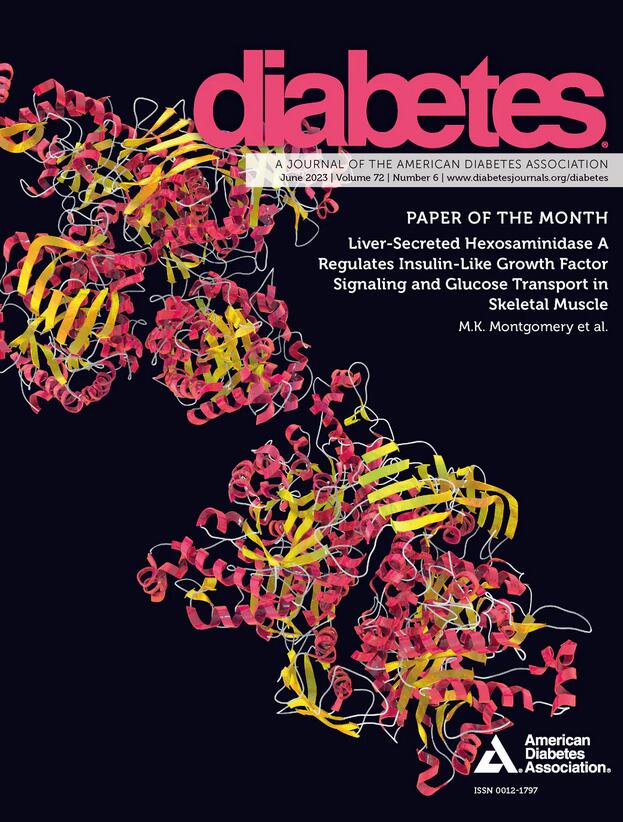GLP-1受体激动剂Dulaglutide通过体重无关机制减轻肥胖症的肝脂肪变性
IF 7.5
1区 医学
Q1 ENDOCRINOLOGY & METABOLISM
引用次数: 0
摘要
最近的临床试验测试胰高血糖素样肽-1受体激动剂(GLP-1 RAs)显示改善肥胖相关并发症的结果,包括心血管事件和肝脂肪变性。尽管有积极的作用,GLP-1 RAs的益处是由于体重减轻还是直接的治疗效果尚不清楚。因此,我们配对给中年低密度脂蛋白受体敲除(Ldlr - / -)小鼠喂食西方高脂肪饮食,以模拟复杂动脉粥样硬化和代谢功能障碍相关的脂肪性肝病(MAFLD),然后给予杜拉鲁肽或安慰剂,每周两次,持续6周。与年轻的Ldlr - / -小鼠相比,年老的Ldlr - / -小鼠会出现类似于人类病变的加速动脉粥样硬化和晚期MAFLD。与体重匹配的安慰剂治疗小鼠相比,杜拉鲁肽改善了独立于体重的葡萄糖耐量和MAFLD,但对胰岛素敏感性或动脉粥样硬化没有影响。肝脂肪变性的减少是由于新生脂肪生成减少和脂肪组织脂肪分解减少。这些变化与炎症和氧化应激的改善有关,肝脏中m1样巨噬细胞明显衰减。因此,杜拉鲁肽对肝脏具有治疗作用,可能进一步与GLP-1 ra介导的体重减轻协同作用,以减少肝脏脂肪变性和炎症,这是肥胖的主要并发症。胰高血糖素样肽-1受体激动剂是治疗各种肥胖相关疾病的有希望的疗法;然而,这种机制与减肥的好处是复杂的。杜拉鲁肽对肝脏具有不依赖体重的治疗作用,可减轻肝脂肪变性,改善肝功能。杜拉鲁肽降低肝脏中的脂肪新生、脂滴稳定性、炎症和氧化应激以及脂肪组织中的脂肪分解。减肥可能在胰高血糖素样肽-1受体激动剂降低冠状动脉疾病风险的作用中起重要作用。本文章由计算机程序翻译,如有差异,请以英文原文为准。
The GLP-1 Receptor Agonist Dulaglutide Attenuates Hepatic Steatosis in Obesity via a Weight-Independent Mechanism
Recent clinical trials testing glucagon-like peptide-1 receptor agonists (GLP-1 RAs) demonstrated improved outcomes in obesity-associated complications, including cardiovascular events and hepatic steatosis. Despite their positive effects, whether the benefits of GLP-1 RAs are due to weight loss or are a direct therapeutic effect remains unclear. Therefore, we pair fed middle-aged low-density lipoprotein receptor knockout (Ldlr−/−) mice a western high-fat diet to model complex atherosclerosis and metabolic dysfunction–associated fatty liver disease (MAFLD) and then administered dulaglutide or placebo twice a week for 6 weeks. Older compared with younger Ldlr−/− mice develop accelerated atherosclerosis resembling human lesions, and advanced MAFLD. Dulaglutide improved glucose tolerance and MAFLD independent of weight but had no effects on insulin sensitivity or atherosclerosis compared with weight-matched placebo-treated mice. The diminished hepatic steatosis was attributed to both decreased de novo lipogenesis and reduced adipose tissue lipolysis. These changes were associated with amelioration of inflammation and oxidative stress with a marked attenuation in M1-like macrophages in the liver. Therefore, dulaglutide has therapeutic effects on the liver that may further synergize with GLP-1 RA–mediated weight loss to reduce hepatic steatosis and inflammation, a major complication of obesity. ARTICLE HIGHLIGHTS Glucagon-like peptide-1 receptor agonists are promising therapies in treating various obesity-associated diseases; however, the mechanisms are convoluted with the benefits of weight loss. Dulaglutide has weight-independent therapeutic effects on the liver, reducing hepatic steatosis and improving liver function. Dulaglutide reduces de novo lipogenesis, lipid droplet stability, inflammation, and oxidative stress in the liver and lipolysis in adipose tissue. Weight loss may play an important role in glucagon-like peptide-1 receptor agonists’ effect on decreasing coronary vascular disease risk.
求助全文
通过发布文献求助,成功后即可免费获取论文全文。
去求助
来源期刊

Diabetes
医学-内分泌学与代谢
CiteScore
12.50
自引率
2.60%
发文量
1968
审稿时长
1 months
期刊介绍:
Diabetes is a scientific journal that publishes original research exploring the physiological and pathophysiological aspects of diabetes mellitus. We encourage submissions of manuscripts pertaining to laboratory, animal, or human research, covering a wide range of topics. Our primary focus is on investigative reports investigating various aspects such as the development and progression of diabetes, along with its associated complications. We also welcome studies delving into normal and pathological pancreatic islet function and intermediary metabolism, as well as exploring the mechanisms of drug and hormone action from a pharmacological perspective. Additionally, we encourage submissions that delve into the biochemical and molecular aspects of both normal and abnormal biological processes.
However, it is important to note that we do not publish studies relating to diabetes education or the application of accepted therapeutic and diagnostic approaches to patients with diabetes mellitus. Our aim is to provide a platform for research that contributes to advancing our understanding of the underlying mechanisms and processes of diabetes.
 求助内容:
求助内容: 应助结果提醒方式:
应助结果提醒方式:


